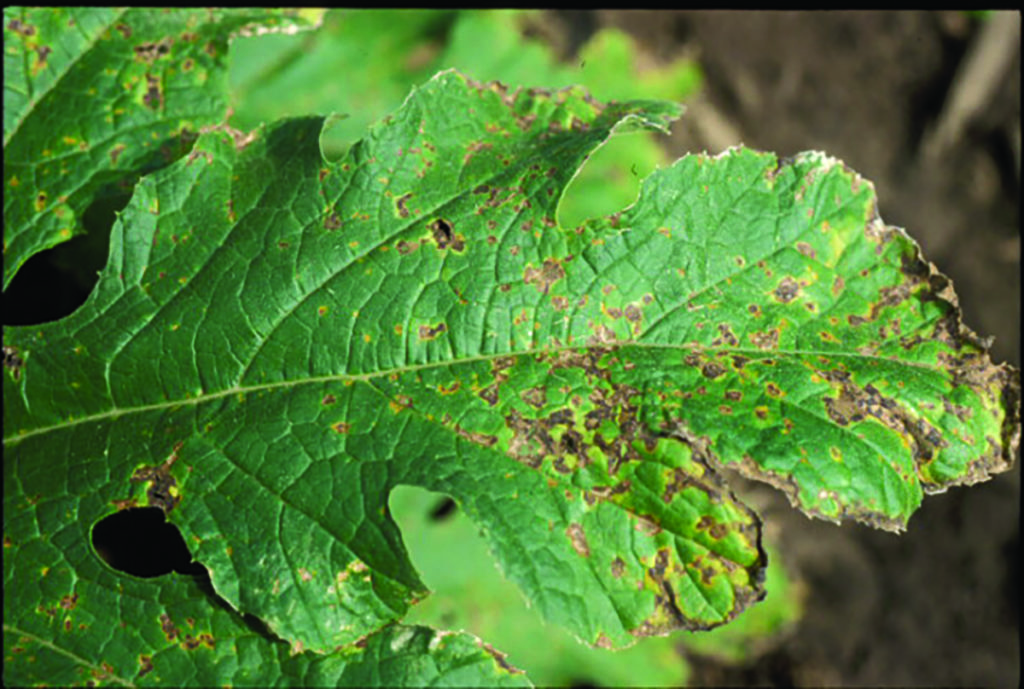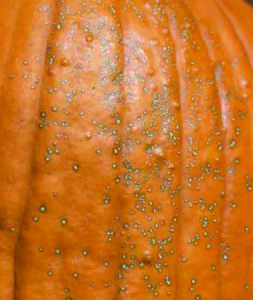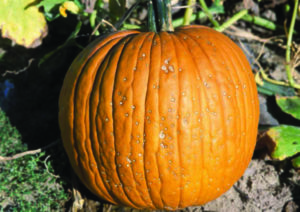

Mar 27, 2019Illinois expertise tackles pumpkin bacterial spot
Bacterial spot of pumpkin is a serious emerging disease affecting pumpkin growers around the world. However, University of Illinois researchers and Extension personnel are at the forefront of understanding the problem and how to manage it.
Illinois produces roughly three times more pumpkins than any other state, and large-scale processing pumpkin production occurs near Morton and Peoria for Libby’s brand canned pumpkin.
The usual suspect
The disease itself is caused by a bacterium called Xanthomonas cucurbitae, said Mohammad Babadoost, University of Illinois professor of plant pathology and Extension specialist. A scratch or injury to the pumpkin will give the bacteria a foothold to form a lesion on the skin of the pumpkin and eventually colonize and ruin the whole fruit.
“This disease was not really significant until 2005,” he said. Incidence and severity have increased since that time, and it’s now considered a serious pumpkin disease not only in the United States, but also everywhere that pumpkins are grown, for instance in Austria, Babadoost said.


Photos: Mohammad Babadoost/University of Illinois
“It’s almost a worldwide problem,” he said.
The bacteria are carried in and on the seeds, and can survive with infected plant tissues for more than two years in the soil, he said. Researchers are still trying to work out how it moves from seed to sprouts, but it’s been found on pumpkin plants still in the four-leaf stage. Leaf infections are less concerning than fruit infections, Babadoost said.
The disease hits jack-o-lanterns (Cucurbita pepo) worse than the varieties used for canning (Cucurbita
moschata), Babadoost said. Growers growing pumpkins for processing have another advantage over jack-o-lantern farmers: Their pumpkins are not stored for lengthy periods of time after harvest, going to the canning facility usually within 24 hours. Cutting into infected pumpkins or leaving them in wet conditions only accelerates their decay.
What to do
As with any bacteria, plant pathogen, sanitation is key, Babadoost said. Pumpkins with lesions can be removed from the field and stored in dry areas – although, he said it’s unfortunate most growers don’t notice the lesions until the fruit changes color.
The seed-borne bacteria can be stopped before planting.
“We have the methods to eradicate any bacteria that is in or on the seed,” he said.
As far as chemical treatments go, Babadoost is recommending a copper mixture to the Illinois growers. Copper hydroxide – Cu(OH)2 (e.g., Kocide-3000) – can be mixed with Manzate Pro-Stick, Quintec or Cueva and spray-applied. The biocontrol agent Regalia, can also be mixed with copper for a similar effect.
“All these compounds are not silver bullets,” he said. “Most of them reduce the severity of the disease significantly.” For instance, he said, a field that would normally have a 70 percent infection rate of fruits could have it reduced to only 20 percent.
Babadoost recommends applying sprays from the time of fruit set.


Weather issue
Nathan Johanning, a University of Illinois Extension educator based in Murphysboro, had a chance to observe the rain’s effect in the past season. After big rain in southern Illinois, a university trial of different pumpkin varieties developed bacterial spot lesions.
“The weather, unfortunately, can be the biggest factor,” he said. “It had dumped 4.5 to 5 inches in one night and that type of event seemed to be really problematic.”
While the pumpkin varieties in the trial were planted in a flat field, Johanning observed that his pumpkin patch planted on a slope about 70 miles away were not equally affected, perhaps because the water drained away more quickly.
“It is sort of an unintentional experiment of sorts,” he said.
Johanning contrasts the past season’s rain to the relatively dry fall of 2017 when he didn’t hear many complaints about bacterial spot.
Crop rotation can help avoid bacterial spot to a degree, and also choosing a well-drained field.
“That’s important, although we know that we’re often severely limited in the geography we have,” he said.
— Stephen Kloosterman, associate editor














